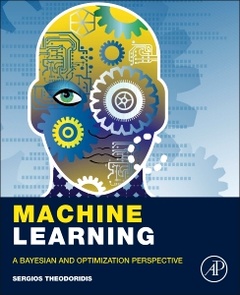Machine Learning A Bayesian and Optimization Perspective
Auteur : Theodoridis Sergios

This tutorial text gives a unifying perspective on machine learning by covering both probabilistic and deterministic approaches -which are based on optimization techniques ? together with the Bayesian inference approach, whose essence lies in the use of a hierarchy of probabilistic models.The book presents the major machine learning methods as they have been developed in different disciplines, such as statistics, statistical and adaptive signal processing and computer science. Focusing on the physical reasoning behind the mathematics, all the various methods and techniques are explained in depth, supported by examples and problems, giving an invaluable resource to the student and researcher for understanding and applying machine learning concepts.
The book builds carefully from the basic classical methods to the most recent trends, with chapters written to be as self-contained as possible, making the text suitable for different courses: pattern recognition, statistical/adaptive signal processing, statistical/Bayesian learning, as well as short courses on sparse modeling, deep learning, and probabilistic graphical models.
1. Introduction2. Probability and Stochastic Processes3. Learning in Parametric Modeling: Basic Concepts and Directions4: Mean-Square Error Linear Estimation5. Stochastic Gradient Descent: The LMS Algorithm and Its Family6. The Least-Squares Family7. Classification: A Tour of the Classics8. Parameter Learning: A Convex Analytic Path9. Sparsity-Aware Learning: Concepts and Theoretical Foundations10. Sparsity-Aware Learning: Algorithms and Applications11. Learning in Reproducing Kernel Hilbert Spaces12. Bayesian Learning: Inference and the EM Algorithm13. Bayesian Learning: Approximate Inference and Nonparametric Models14. Monte Carlo Methods15. Probabilistic Graphical Models: Part 116. Probabilistic Graphical Models: Part 217. Particle Filtering18. Neural Networks and Deep Learning19. Dimensionality Reduction and Latent Variables Modeling
University Researchers, R&D engineers, graduate students taking a machine learning course.
He has received a number of prestigious awards, including the 2014 IEEE Signal Processing Magazine Best Paper Award, the 2009 IEEE Computational Intelligence Society Transactions on Neural Networks Outstanding Paper Award, the 2017 European Association for Signal Processing
(EURASIP) Athanasios Papoulis Award, the 2014 IEEE Signal Processing Society Education Award, and the 2014 EURASIP Meritorious Service Award. He has served as president of EURASIP and vice president for the IEEE Signal Processing Society and as Editor-in-Chief IEEE Transactions on Signal processing. He is a Fellow of EURASIP and a Life Fellow of IEEE.
He is the coauthor of the best selling book Pattern Recognition, 4th edition, Academic Press, 2009 and of the book Introduction to Pattern Recognition: A MATLAB Approach, Academic Press, 2010.
- All major classical techniques: Mean/Least-Squares regression and filtering, Kalman filtering, stochastic approximation and online learning, Bayesian classification, decision trees, logistic regression and boosting methods.
- The latest trends: Sparsity, convex analysis and optimization, online distributed algorithms, learning in RKH spaces, Bayesian inference, graphical and hidden Markov models, particle filtering, deep learning, dictionary learning and latent variables modeling.
- Case studies - protein folding prediction, optical character recognition, text authorship identification, fMRI data analysis, change point detection, hyperspectral image unmixing, target localization, channel equalization and echo cancellation, show how the theory can be applied.
- MATLAB code for all the main algorithms are available on an accompanying website, enabling the reader to experiment with the code.
Date de parution : 05-2015
Ouvrage de 1062 p.
19x23.3 cm
Épuisé
